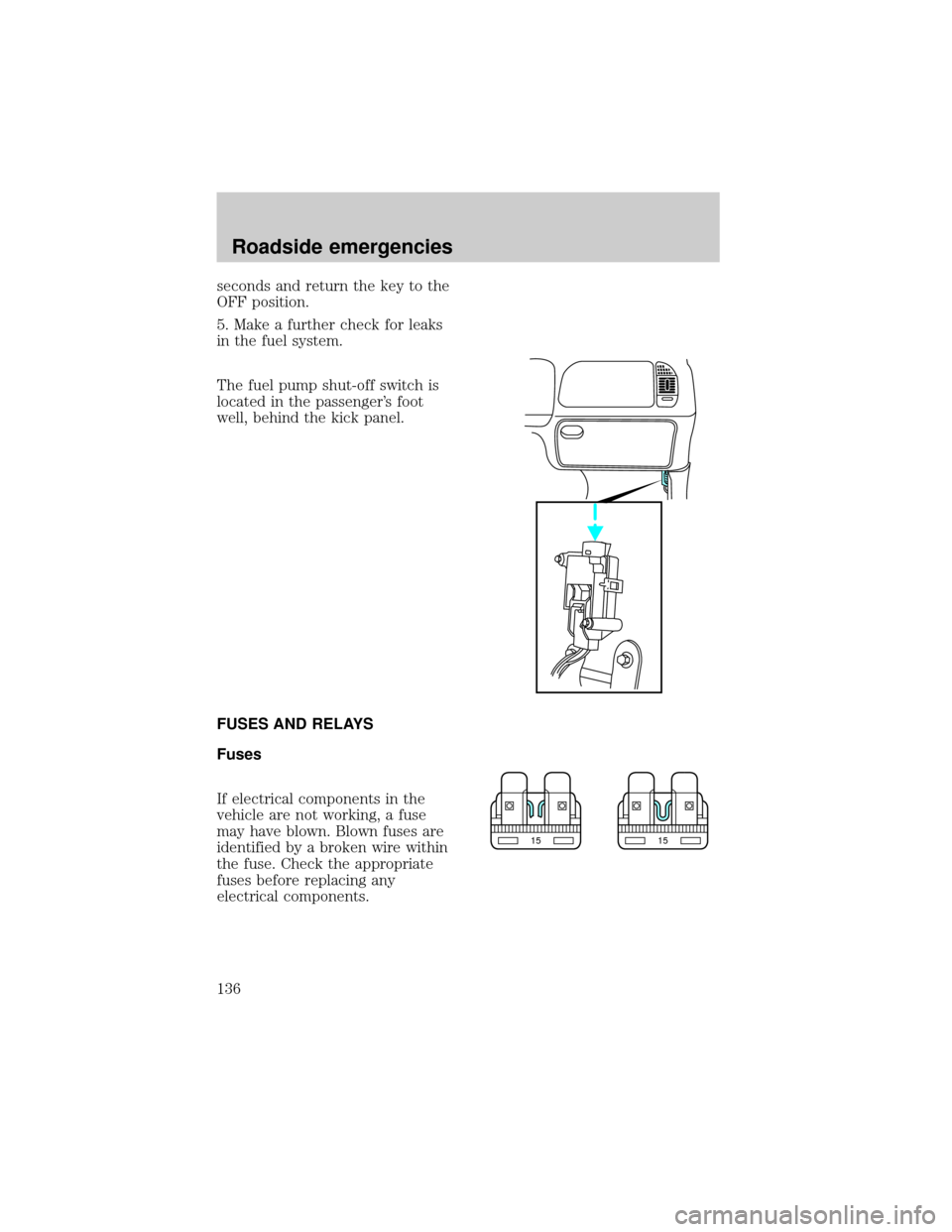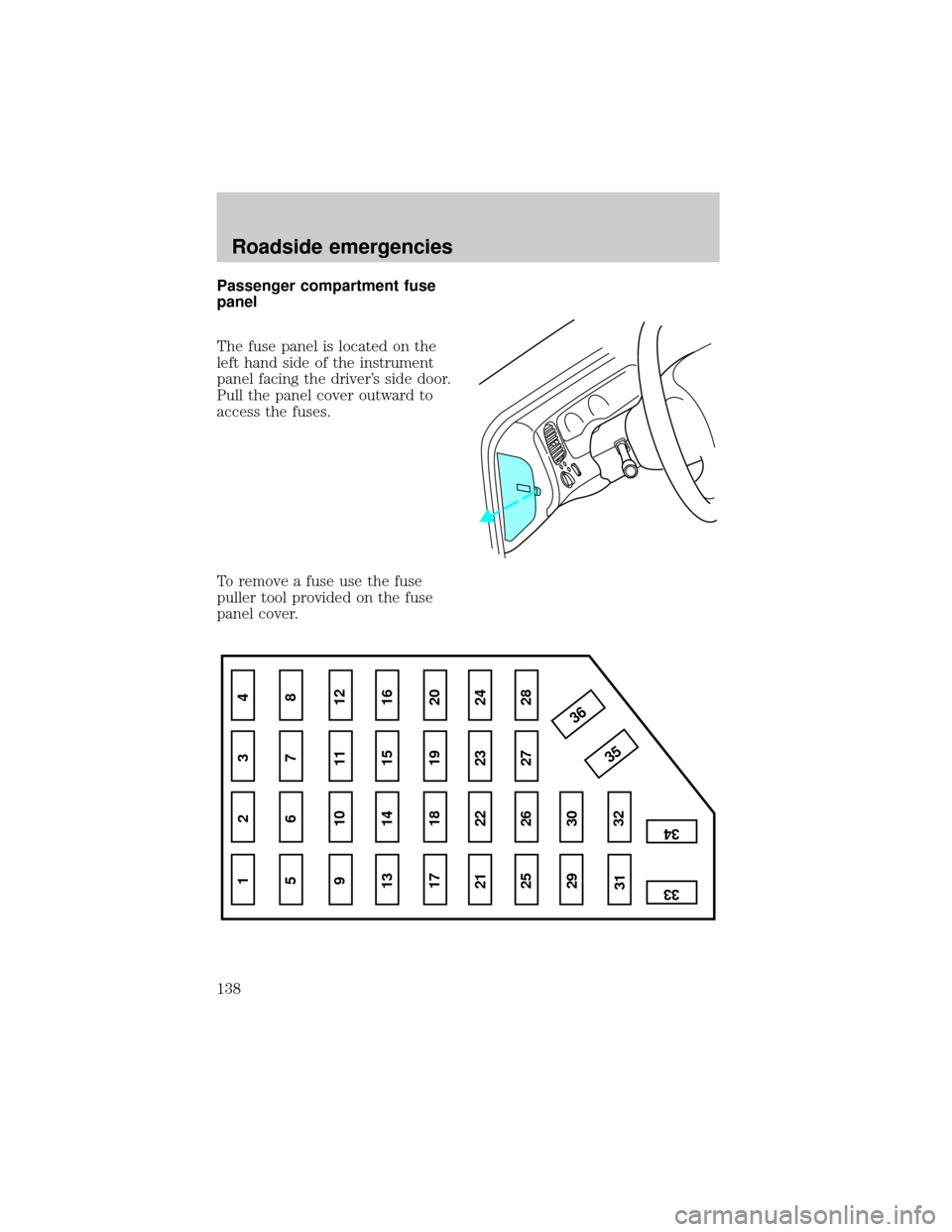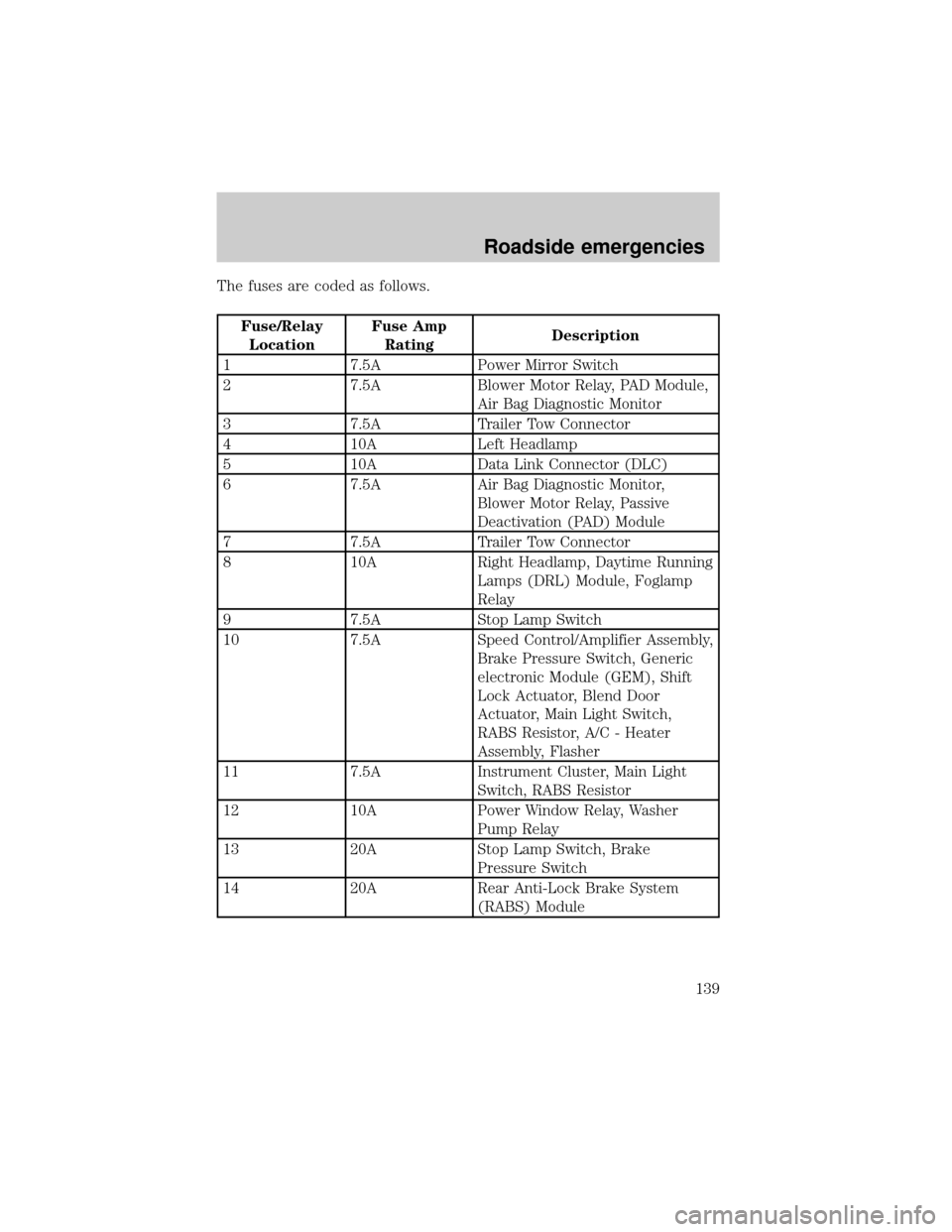Mercury Mountaineer 1998 Owner's Manuals
Manufacturer: MERCURY, Model Year: 1998, Model line: Mountaineer, Model: Mercury Mountaineer 1998Pages: 216, PDF Size: 1.72 MB
Page 131 of 216

for hooking up trailer lamps.
Using a step bumper
The rear bumper is equipped with
an integral hitch and requires only
a ball with a 19 mm (3/4 inch)
shank diameter. The bumper has a
1 590 kg (3 500 lb.) trailer weight
and 159 kg (350 lb.) tongue weight
capability.
Use a frame-mounted weight
distributing hitch for trailers over
1 590 kg (3 500 lb).
Driving while you tow
Do not drive faster than 88 km/h
(55 mph) when towing a trailer.
Speed control may shut off if you
are towing on long, steep grades.
When towing a trailer:
²Use D (Drive) or a lower gear
when towing up or down steep
hills. This will eliminate
excessive downshifting and
upshifting for optimum fuel
economy and transmission
cooling.
²Anticipate stops and brake
gradually.
Servicing after towing
If you tow a trailer for long
distances, your vehicle will require
more frequent service intervals.
Refer to the Severe Duty Schedule
in your ªService Guideº for more
information.
Driving
131
Page 132 of 216

Trailer towing tips
²Practice turning, stopping and
backing up in an area before
starting on a trip to get the feel
of the vehicle trailer
combination. When turning,
make wider turns so the trailer
wheels will clear curbs and
other obstacles.
²Allow more distance for
stopping with a trailer attached.
²The trailer tongue weight should
be 10±15% of the loaded trailer
weight.
²After you have traveled 80 km
(50 miles), thoroughly check
your hitch, electrical
connections and trailer wheel
lug nuts.
²When stopped in traffic for long
periods of time in hot weather,
place the gearshift in P (Park)
and increase idle speed. This
aids engine cooling and air
conditioner efficiency.
²Vehicles with trailers should not
be parked on a grade. If you
must park on a grade, place
wheel chocks under the trailer's
wheels.
Launching or retrieving a boat
When backing down a ramp during
boat launching or retrieval,
²Do not allow the static water
level to rise above the bottom
edge of the rear bumper and
Driving
132
Page 133 of 216

²Do not allow waves to break
higher than 15 cm (six inches)
above the bottom edge of the
rear bumper.
Exceeding these limits may allow
water to enter critical vehicle
components, adversely affecting
driveability, emissions and
reliability.
If the rear axle is submerged in
water, the rear axle lubricant
should be checked and changed, if
necessary. The rear axle is filled
with a synthetic lubricant and does
not normally require a lubricant
change for the life of the vehicle.
Rear axle lubricant quantities
should not need to be checked
unless a leak is suspected.
Recreational towing (all wheels
on the ground)
Do not tow your vehicle with all
wheels on the ground as vehicle
damage may occur.
LUGGAGE RACK
Maximum load is 44 kg (100 lbs),
evenly distributed. If it is not
possible to distribute the load,
position it as far rearward as
possible. Adjustable tie down loops
(not equipped) must be used to
secure the load.
Driving
133
Page 134 of 216

To adjust cross-bar position:
1. Slide the locking switches at
each end of the crossbar toward
the rear of the vehicle until
UNLOCKED appears.
2. Slide cross-bar to the desired
location.
3. Lock the cross-bar into position
by pushing the locking switches on
each end of the crossbar toward
the front of the vehicle.
The rear rack can be completely
removed in the UNLOCKED
position by sliding the cross-bar
rearward until it frees the guides.
FUEL CONSUMPTION
Fuel economy can be improved by
avoiding:
²lack of regular, scheduled
maintenance
²excessive speed
²rapid acceleration
²extended idle
Driving
134
Page 135 of 216

HAZARD LIGHTS CONTROL
Use only in an emergency to warn
traffic of vehicle breakdown,
approaching danger, etc. The
hazard flashers can be operated
when the ignition is off.
²The hazard lights control is
located on top of the steering
column.
²Depress hazard lights control to
activate all hazard flashers
simultaneously.
²Depress control again to turn
the flashers off.
FUEL PUMP SHUT-OFF SWITCH
If the engine cranks but does not
start after a collision, the fuel
pump shut-off switch may have
been activated. The ªFuel Resetº
indicator light will illuminate in the
instrument cluster. The shut-off
switch is a device intended to stop
the electric fuel pump when your
vehicle has been involved in a
substantial jolt.
1. Turn the ignition switch to the
OFF position.
2. Check the fuel system for leaks.
3. If no fuel leak is apparent, reset
the fuel pump shut-off switch by
pushing in the button on the
switch.
4. Turn the ignition switch to the
ON position. Pause for a few
Roadside emergencies
135
Page 136 of 216

seconds and return the key to the
OFF position.
5. Make a further check for leaks
in the fuel system.
The fuel pump shut-off switch is
located in the passenger's foot
well, behind the kick panel.
FUSES AND RELAYS
Fuses
If electrical components in the
vehicle are not working, a fuse
may have blown. Blown fuses are
identified by a broken wire within
the fuse. Check the appropriate
fuses before replacing any
electrical components.
1515
Roadside emergencies
136
Page 137 of 216

Always replace a fuse with
one that has the specified
amperage rating. Using a fuse
with a higher amperage rating
can cause severe wire damage
and could start a fire.
Standard fuse amperage rating
and color
Fuse rating Color
5 amp Tan
7.5 amp Brown
10 amp Red
15 amp Light blue
20 amp Yellow
20 amp fuse link Light blue
25 amp Natural
30 amp Light green
30 amp fuse link Pink
40 amp fuse link Green
50 amp fuse link Red
60 amp fuse link Yellow
80 amp fuse link Black
100 amp fuse link Dark blue
Roadside emergencies
137
Page 138 of 216

Passenger compartment fuse
panel
The fuse panel is located on the
left hand side of the instrument
panel facing the driver's side door.
Pull the panel cover outward to
access the fuses.
To remove a fuse use the fuse
puller tool provided on the fuse
panel cover.
1 234
5 678
9 101112
13 14 15 16
17 18 19 20
21 22 23 24
25 26
29 30
35 36
313233
34
27 28
Roadside emergencies
138
Page 139 of 216

The fuses are coded as follows.
Fuse/Relay
LocationFuse Amp
RatingDescription
1 7.5A Power Mirror Switch
2 7.5A Blower Motor Relay, PAD Module,
Air Bag Diagnostic Monitor
3 7.5A Trailer Tow Connector
4 10A Left Headlamp
5 10A Data Link Connector (DLC)
6 7.5A Air Bag Diagnostic Monitor,
Blower Motor Relay, Passive
Deactivation (PAD) Module
7 7.5A Trailer Tow Connector
8 10A Right Headlamp, Daytime Running
Lamps (DRL) Module, Foglamp
Relay
9 7.5A Stop Lamp Switch
10 7.5A Speed Control/Amplifier Assembly,
Brake Pressure Switch, Generic
electronic Module (GEM), Shift
Lock Actuator, Blend Door
Actuator, Main Light Switch,
RABS Resistor, A/C - Heater
Assembly, Flasher
11 7.5A Instrument Cluster, Main Light
Switch, RABS Resistor
12 10A Power Window Relay, Washer
Pump Relay
13 20A Stop Lamp Switch, Brake
Pressure Switch
14 20A Rear Anti-Lock Brake System
(RABS) Module
Roadside emergencies
139
Page 140 of 216

Fuse/Relay
LocationFuse Amp
RatingDescription
14 10A 4 Wheel Anti-Lock Brake System
(4WABS) Module, 4WABS Main
Relay
15 7.5A Instrument Cluster
16 30A Windshield Wiper Motor, Wiper
Hi-Lo Relay, Wiper Run/Park
Relay
17 7.5A Cigar Lighter
18 15A Drivers Unlock Relay, All unlock
Relay, All Lock Relay
19 25A PCM Power Diode
20 7.5A RAP Module, Generic Electronic
Module (GEM), Radio
21 15A Flasher (Hazard)
22 20A Auxiliary Power Socket
23 15A Turn Signals
24 - Not Used
25 7.5A Generic Electronic Module
(GEM), Instrument Cluster
26 10A Battery Saver Relay, Electronic
Shift Relay, Interior Lamp Relay,
Power Window Relay, Electronic
Shift Control Module,
Transmission Control
27 15A Switch, DRL, Backup Lamps
Switch, DTR Sensor, Instrument
Illumination Dimming Module,
Dome/Map Lamp, GEM, Electric
Shift, Interior Lights, Glove Box
Lamp and Switch
28 7.5A Generic Electronic Module
(GEM), Radio
29 15A Radio
Roadside emergencies
140